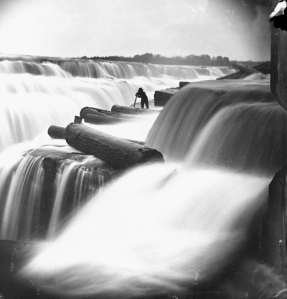Helping Preserve Canada’s Forest History
Last week I traveled to Alliston, Ontario, to meet with the Forest History Society of Ontario and to address the Ontario Forestry Association at their 62nd annual meeting. I went in part to present the FHS Fellow Award to both Dr. Ken Armson and Dr. Yvan Hardy. The Fellow Award is the Society’s highest honor, reserved for those who have made outstanding and persistent contributions to forest history or to Forest History Society programs.

Steve Anderson with Yvan Hardy (l) and Ken Armson (r) with their Fellow Award plaques.
Dr. Armson was recognized for his 50 years in teaching, research, policy and administration in forestry. As a professor of forestry at the University of Toronto for 26 years, he taught and conducted research in forest soils and silviculture. Last year it was his energy that helped establish the Forest History Society of Ontario. Dr. Hardy was recognized for his historic research to combat the spruce budworm, his work as Dean of the Faculty of Forestry and Geodesy at Laval University, and his administrative roles in the federal government including service as Assistant Deputy Minister of the Canadian Forest Service, Natural Resources Canada. As well, he served 15 years on the Forest History Society Board of Directors, including 8 years as co-Vice-Chairman. During the meeting, FHS Board member James Farrell received the Ontario Forestry Association Award for his outstanding contributions to the field of forestry education in Canada and the world, and FHS Board member Mark Kuhlberg spoke about the forest history of Ontario and its impact on communities.
My banquet talk was about “Forest Culture and Storytelling: Inspired by the Forest.” It highlighted the uncertainty in the term “forest culture,” indicating that it has only been during the last 20 years that the term has shown up in the literature in the broad way it is being used today. I also touched on art and literature inspired by the forest and reviewed how a collection of 400 novels in the FHS’ Carl A. Weyerhaeuser Library traces public opinion about forests and forestry during the last century, and how art and literature played a particularly poignant role in the establishment of forestry in America. I ended with a reading of the poem Chaudiere by Douglas Malloch, the “Poet of the Woods.”
The newly formed Forest History Society of Ontario also had their first annual meeting in conjunction with the OFA meeting. The FHSO is the fourth provincial forestry organization to be established. I shared the news about FHS’s new two-year effort in collaboration with the Network in Canadian History & Environment (NiCHE) and the Canadian Forest Service to spearhead the preservation of Canada’s forest history. Efforts include surveying repositories in Canada to determine their willingness and readiness to accept new collections in forest history; seeking out valuable records and collections that need to be preserved; and then trying to facilitate those records to reach an official repository. David Brownstein, sessional faculty at the University of British Columbia, has been contracted in a part-time position to help with the effort. If you know of documents or collections in need of preservation, please contact David or FHS Archivist Eben Lehman. The project will be conducted in cooperation with the provincial forest history associations as well as forestry associations and others who share that goal.
If you want to learn more or support the provincial forest history organizations in Canada, they can be found at:
- Forest History Association of Alberta
- Forest History Association of British Columbia
- Forest History Society of Ontario
- Société d’histoire forestière du Québec (Forest History Society of Quebec)
In addition to our Issue Series book, Canada’s Forests, we have several articles about Canadian forest history available from Forest History Today in PDF format:
- “A Political Football: Federal-Provincial Cooperation in British Columbia Forests, 1930-1995” by Richard A. Rajala
- “Canada in Fish, Game, and Forestry” by Walter P. Stevens
- “A Fortuitous International Meeting of Two Yale Foresters in 1908: H. R. MacMillan and W. N. Millar” by Peter J. Murphy and Robert E. Stevenson
- “Alberta’s Pulp Industry History: Where It Started” by Peter J. Murphy and Robert E. Stevenson
- “From Timber to Biodiversity: The Evolution of British Columbia’s Forest Inventory Program” by John Parminter
- “Dr. G. W. I. Creighton: 75 Years of Leadership in Forestry” by Don Cameron and David Dwyer
- “Tom Wright: Pioneer British Columbia Forester and Tree Farmer” by John Parminter


